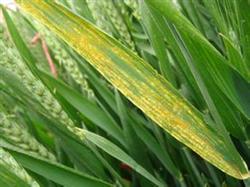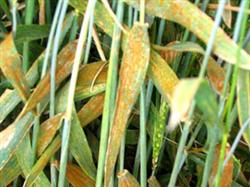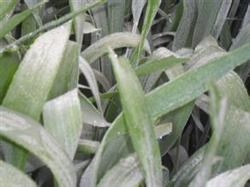Wheat stripe rust can be treated in different areas.

Wheat stripe rust is a serious biological disaster that affects the safe production of wheat in China for a long time. In general epidemic years, the yield of wheat is reduced by 10% by 20%. In extremely epidemic years, the yield can be reduced by more than 60%, and even there is almost no harvest of wheat. According to the comprehensive analysis of the number of bacterial sources, weather conditions and variety distribution, it is predicted that the occurrence of wheat stripe rust in China in 2011 is about 30 million mu. Among them, northwest Sichuan, Longnan, southern Shaanxi, southern Henan, * most, Ningxia late mature wheat areas and other places will be moderate or more popular. Recently, a large central disease group of wheat stripe rust has been found in Mianyang, Sichuan, Shiyan, Hubei and Hanzhong, Shaanxi. Because of the high prevalence and infectivity of stripe rust, the disease propagates and spreads very fast under suitable temperature and humidity. At present, it is a critical period for the growth of wheat turning green and jointing in the main wheat producing areas in China. with the rise of air temperature, wheat stripe rust will gradually enter the peak period of occurrence. Agricultural departments at all levels should attach great importance to disease prevention and control as a key measure to seize a bumper harvest of summer grain, strengthen disease monitoring, adopt regional control strategies, select varieties of high-efficiency chemicals, prevent and control diseases in time, and ensure a bumper wheat harvest. Strengthen disease monitoring: agricultural plant protection departments at all levels should closely monitor the occurrence of wheat stripe rust in accordance with the standards for the prediction and investigation of wheat stripe rust, and conscientiously do a good job in the fixed-point observation and field survey of the disease; accurately grasp the growth and decline of stripe rust; timely issue forecasts and prevention and control warnings according to the development and changes of the disease; timely inform government departments and higher-level business departments of the occurrence of the disease, so as to provide a reliable basis for disease prevention and control decisions. Adopt regional prevention and control strategy: at present, we should focus on the early chemical control in winter breeding areas such as northwest Hubei, Sichuan Basin, southern Henan, southern Shaanxi, Chongqing, Guizhou, Yunnan, etc., and take "drug reconnaissance" to the key diseased fields. "find a point to control one piece", control the disease center in time; provide unified control of wheat fields to control the regional spread of the disease. In spring epidemic areas such as Huang-Huai-Hai, it is necessary to strengthen disease monitoring and carry out spraying prevention and control when the disease rate reaches the standard (the rate of diseased leaves reaches 5%). The over-summer variable areas (autumn bacterial source base), such as southeast Gansu, northwest Sichuan, Ningnan and Haidong, should be treated by comprehensive measures such as anti-rust improved varieties and chemical dressing, combined with stop-wheat planting and suitable late varieties. Select varieties of high-efficiency agents: vigorously promote high-efficiency and low-toxic internal inhalation fungicides based on triazoles and enazoles for field spray control, with 15% triadimefon powder 80-100 grams per mu, or 25% diniconazole powder 30-40 grams per mu, or 12.5% suspension agent 40 ml spray control, the control effect can reach more than 90%.
- Prev

There is a wonderful way to prevent wheat freezing injury
What is wheat rust? Wheat rust is also called jaundice. There are three kinds of rust: stripe rust, leaf rust and stem rust. A disease that occurs most widely and causes most damage to wheat. After wheat rust infection, chlorotic spots appear on the surface of wheat leaves or straw at the initial stage, and yellow or reddish brown powder blisters grow later, that is, the pathogen summer spore pile.
- Next

How is wheat downy mildew transmitted?
How is wheat downy mildew transmitted? Wheat downy mildew is a fungal disease. The pathogen oversummered in the host diseased tissue with oospores. The oospores germinate and produce sporangia when the conditions are suitable. Oospores and sporangia spread by running water, germinate and produce zoospores, which invade from coleoptile to hyphae, and hyphae penetrate into host larvae.
Related
- The first cup of black tea in spring, the flavor and history of tea gardens in Kenya, Africa
- The computer can not only choose potatoes, but also grow tea rice. AI will grow winter oolong tea champion.
- It is not only the inflated tea bitten by insects, but also engraved with the four seasons tea in Beipu.
- The Oriental Beauty Tea Festival in Zhuxian County takes the stage at the weekend to experience the plus-size feast of oil tea.
- & quot; Oriental Beauty Tea & Exploration of Emei in Hsinchu, the hometown of quot;
- The new variety of strawberry "Tainong 1" dessert is the first choice with mellow aroma. Crimson gorgeous
- History of Tea in Taiwan: from Wild Inner Mountain to Export Tea Garden
- Two types of Taiwan Oriental Beauty Black Tea won the British three-Star Award for Childhood Tea Xiang Zhang Jiaqi changed from pilot to champion tea maker.
- Banana species and varieties: the planting history of Taiwan Xianren banana and dwarf banana is long, is banana disease resistant?
- Coffee planting Technology: Qianjie Coffee from Seedling to harvesting

